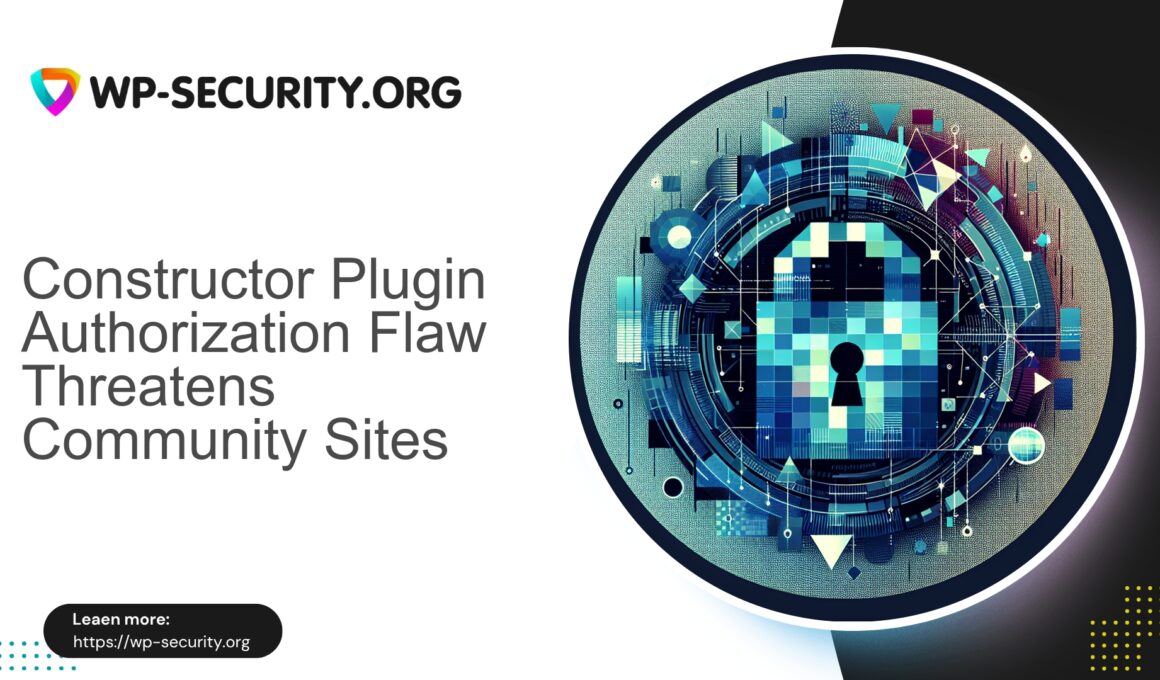| Plugin Name | Constructor |
|---|---|
| Type of Vulnerability | Missing Authorization |
| CVE Number | CVE-2025-9194 |
| Urgency | Low |
| CVE Publish Date | 2025-10-03 |
| Source URL | CVE-2025-9194 |
Constructor WordPress Plugin — CVE-2025-9194 (Missing Authorization)
Author: Hong Kong Security Expert — concise technical advisory and mitigation guidance for site owners and administrators.
Executive summary
The Constructor WordPress plugin is affected by CVE-2025-9194, a missing authorization vulnerability disclosed on 2025-10-03. The weakness concerns certain plugin endpoints that do not properly enforce capability checks, allowing unauthorized users to access or query resources that should be restricted. The CVE is rated as Low urgency; the practical impact depends on which endpoints are exposed and the server configuration. Administrators should evaluate exposure immediately and apply mitigations where appropriate.
Affected components and scope
– Plugin: Constructor
– Vulnerability type: Missing authorization (privilege checks absent or insufficient for certain plugin endpoints)
– CVE: CVE-2025-9194 (published 2025-10-03)
– Urgency: Low — limited impact on confidentiality and integrity in typical default configurations, but situational risk if endpoints expose sensitive configuration or administrative actions.
Technical analysis
Missing authorization means that code paths intended for authenticated or privileged users do not verify the caller’s capabilities before returning data or performing operations. In WordPress plugins this often affects REST API endpoints or AJAX handlers that rely on assumptions about user context.
For Constructor, the issue manifests as one or more endpoints that respond without required capability checks. Depending on the endpoint, an unauthenticated or low-privilege user could retrieve configuration details, theme/template metadata, or other plugin-managed data. The vulnerability does not necessarily permit full administrative takeover, but can leak information useful for follow-on attacks or targeted abuse.
Typical indicators
- Unprotected REST endpoints under /wp-json/constructor/ or similarly named routes responding to unauthenticated requests.
- AJAX handlers (admin-ajax.php) that process requests without verifying current_user_can() or nonce checks where required.
- Exposed plugin settings or template JSON returned to callers without capability verification.
Proof-of-concept (illustrative)
Below is an illustrative example showing how an unauthenticated GET request against a plugin REST route could return data when authorization checks are missing. Modify the path to match confirmed endpoints in your installation.
curl -s -X GET "https://example.com/wp-json/constructor/v1/settings" -H "Accept: application/json"If this request returns configuration data without requiring authentication, it indicates missing authorization controls. Do not assume the exact route above exists on your site — scan for constructor-related routes using discovery techniques and inspect their access control.
Impact assessment
Impact varies by endpoint and site context:
- Low/Information disclosure: Exposure of non-sensitive configuration or template metadata.
- Moderate: If endpoints reveal API keys, integration tokens, or admin-only URLs, the risk increases.
- Chained attacks: Information obtained may aid phishing, targeted attacks, or discovery of other vulnerabilities.
Mitigation and response
Immediate actions for administrators in Hong Kong and elsewhere:
- Inventory: Identify installations of the Constructor plugin across your estate and list active versions.
- Scan endpoints: Use authenticated and unauthenticated discovery to enumerate plugin routes (REST endpoints, AJAX actions). Verify whether endpoints perform capability checks or require nonces.
- Apply updates: If the plugin author has issued a patch, update to the fixed version promptly.
- Temporarily disable: If a patch is not yet available and sensitive data is exposed, consider disabling the plugin until a fix can be tested and deployed.
- Restrict access: Use server-level controls (IP allowlists, basic auth on virtual host, or web server rules) to limit access to known administrative addresses if feasible.
- Least privilege: Ensure accounts and API tokens follow least-privilege principles and rotate any credentials that may have been exposed.
- Monitor: Check web server logs and WordPress access logs for anomalous requests to constructor-related routes and investigate suspicious activity.
- Code review: If you maintain custom integrations, inspect code for assumptions about user context and add robust capability checks (current_user_can()) and nonce verification where applicable.
Detection guidance
Practical checks:
- Curl test: Attempt unauthenticated GET/POST requests against discovered plugin endpoints and observe response codes and payload.
- Log review: Search for repeated or automated access patterns to constructor endpoints that could indicate reconnaissance.
- Automated scans: Run secure configuration scans that validate REST endpoints require authentication where appropriate.
Disclosure timeline & references
– CVE published: 2025-10-03 (CVE-2025-9194).
– Reference record: CVE-2025-9194
Notes from a Hong Kong security perspective
Hong Kong site operators should treat plugin vulnerabilities pragmatically: prioritise exposure reduction and quick containment for plugins that touch front-end rendering or site configuration. Many local businesses host single-site WordPress installs on shared hosting — if you cannot quickly apply patches or restrict access, consider disabling non-essential plugins and ensuring backups are in place before making changes.
